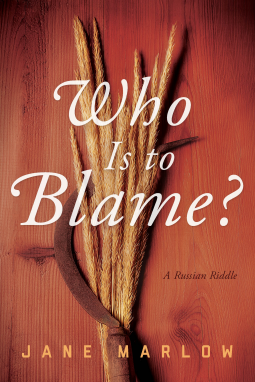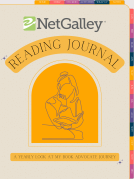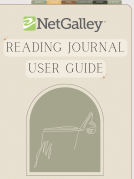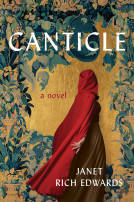
Who Is to Blame?
A Russian Riddle
by Jane Marlow
This title was previously available on NetGalley and is now archived.
Send NetGalley books directly to your Kindle or Kindle app
1
To read on a Kindle or Kindle app, please add kindle@netgalley.com as an approved email address to receive files in your Amazon account. Click here for step-by-step instructions.
2
Also find your Kindle email address within your Amazon account, and enter it here.
Pub Date Oct 18 2016 | Archive Date Aug 31 2019
Greenleaf Book Group | River Grove Books
Description
NOTE: This is book 1 in the series. Books 2 and 3 are also available on NetGalley!
Jane Marlow's debut novel is a beautifully written twenty-five-year saga of two families--one born of noble heritage and the other bound as serfs to the noble's household. Set during the mid-1800s in the vast grain fields of Russian, Who Is to Blame? follows the lives of two star-crossed serfs, Elizaveta and Feodor, torn apart by their own families and the Church while simultaneously trapped in the inhumane life of poverty to which they were born.
At the other end of the spectrum, Count Maximov and his family struggle to maintain harmony amidst a tapestry of deception and debauchery woven by the Count's son. The plot twists further when the Tsar emancipates twenty million serfs from bondage while the rural gentry's life of privilege and carelessness has taken its final bow and much of Russia's nobility faces possible financial ruin.
Aficionados of historical fiction will be captivated by the lyrical flow of Marlow's intertwining stores of love, loss, courage, and pain against her backdrop of social upheaval. The novel's riddles flow subtly throughout, spurring readers to ponder where the blame actually lies. In the end, we must tap into our own hearts to navigate teh depths and quandaries of the author's perplexing question.
Advance Praise
- Mark Schauss, host of the Russian Rulers History podcast
Available Editions
| EDITION | Other Format |
| ISBN | 9781632991041 |
| PRICE | $14.95 (USD) |
Average rating from 57 members
Featured Reviews
 Victoria Z, Reviewer
Victoria Z, Reviewer
Disclaimer: I received this book free of charge from the publisher via NetGalley in exchange for my honest review. All opinions are my own.
This story follows two main families in the village/estate of Petrovo, Russia: Elizabeta Anafrev of the serf/peasant class and the Maximov family of the noble class, led by Count Stepan Maximov. The book follows Elizabeta and Stepan throughout their lives, even intermingling from time to time. Stepan is in charge of his estate and his serfs, and the caste system keeps the serfs always a bit hungry and overworked while the noble class enjoys lavish dinners and fancy balls.
The disconnect between the aristocracy and the common folk was often astonishing for me. One winter in particular, Elizaveta and her family starve, and she gets gravely ill. Stepan ends up buying grain for the peasants to use, but according to them he never really does enough, and they are always in his service though Stepan is a rather benevolent ruler. I couldn't imagine living through those trying times, especially a woman as strong-willed and outspoken as Elizaveta. She's got a lot of things working against her: town gossip threatens to ruin her reputation from time to time, and she's in love with her best friend Feodor. The problem? Feodor and Elizaveta are spiritual family - his parents are her godparents and therefore it is completely forbidden for them to ever have a romantic relationship. Then, as an agreement with Count Maximov, the children of marrying age in the village have to have marriages arranged. It's almost certain that Feodor and Elizaveta will never be able to be together.
Or is it?
The story spans decades, starting with Elizaveta and moving on to her married life with her abusive husband and her children. Similarly, the story for the Maximov estate starts with Stepan and his wife Sophie after the death of one of their children, and the lives of the rest of their children through adulthood.
Through this interesting way of storytelling, The reader hears of the growth and progression of other characters, such as Feodor. I fell in love with these characters. The development of the characters in this story was unlike anything I've ever seen. The hardships, the happy moments, the despair. I was feeling it all and experiencing it all with them.
The end of the book leaves many loose ends to tie, and I like it that way. I daydream about a sequel, or at least what happens next. Fantastic read for me.
 angie b, Librarian
angie b, Librarian
This is a beautifully worded story that reads like a dark Russian fairy tale, steeped in lore and tradition, spanning decades, miles, and many people who become dear to the reader as the story progresses. Reminded me of Margo Lanagan's Tender Morsels.
 Douglas O, Reviewer
Douglas O, Reviewer
I am reviewing this on NetGalley.com. This is a very perceptive portrayal of the sorrows and joys of Russian serfs families in the latter half of the nineteenth century. It is very well researched and vividly recounted. The characters are well drawn and the reader follows their ups and downs with trepidation about what might happen next to the more attractive characters and hoping for calamity to reach the evil doers. It portrays Russian society very accurately, including references to changes brought about the Tsar Alexander to the structure of Russian society and the effects of these. A good read.
 Elena C, Reviewer
Elena C, Reviewer
As a professional Russianist, I approached this book with both curiosity and trepidation. I'm always excited to see a Western book with a Russian theme, but at the same time, I'm so often disappointed in the execution. "Who Is to Blame?" definitely reads more like a Western take on a Russian theme than like actual Russian literature, but it will probably appeal much more to English-language readers because of that.
The novel is a fact-dense piece of historical fiction about a particularly turbulent period in Russian history (aren't they all!): the 1840s through the 1860s, culminating in the emancipation of the serfs. It is full of the kind of period detail that historical fiction readers seem to like; in fact, in tone, despite its rather dark subject matter, it reminded me of a historical romance novel, with its careful--and obviously lovingly researched--descriptions of food, clothing, holidays, laws, and so on. This is not to say that it is a dry collection of facts, but rather that readers who enjoy that kind of novel are likely to take pleasure in the detailed (and astonishingly accurate for a Western work) descriptions of how the people of mid-19th-century Russia lived. The tragedy and brutality of people's day-to-day lives is depicted with courage, but there is also the hope that things could get better, and that the main characters will be able to turn their lives around and find some kind of happiness.
Like any good historical novel, it starts off slowly, allowing the reader to become immersed in the characters and their world, but the tension builds and builds, and I found the last 100 pages completely enthralling. It ends not exactly on a cliffhanger, but in a place that suggests the possibility of a sequel, hinting at a family saga-type series. This is not a light read, and English speakers may struggle a bit with the Russian names (although they are presented with the maximum possible clarity for non-Russian-speakers), but anyone looking for a satisfyingly dense historical novel about Russia would do well to check this book out.
My thanks to NetGalley for providing a review copy of this book.
 Linda Z, Reviewer
Linda Z, Reviewer
I would like to thank NetGalley and the Publisher for an ARC of "Who is to Blame?" by Jane Marlow. This is a historical fiction genre set during 19th century Russia, and spanning over 25 years. The drama takes place between the Noble Class,(by heritage), and the serfs who tend the land and are born into poverty. Within each class, Jane Marlow writes about romance, conflicts, betrayal,family,loyalty, love, revenge., and power.Within the setting, the Tsar emancipates the serfs, and ongoing conflicts occur. The history is written well, and the characters are complex and conflicted as dictated by the times and circumstances. I enjoyed reading this novel and would recommend it for those who enjoy historical fiction. The author leaves us with the question,"Who is to blame?" for the social upheaval.
 Maren R, Reviewer
Maren R, Reviewer
very interesting historical fiction that is wonderfully written with unexpected little moments -the riddles! i was not expected those and they did add quite something to the story overall! If you are interested in russia and want a nice historical fiction, give this a try!
 Cydne W, Reviewer
Cydne W, Reviewer
This book definitely stays true to its Russian roots; which leaves me work mixed feelings.
On the one hand, the characters had were complex, the protagonist was easy to root for, and the book was well-written. On the other hand, the ending was extremely abrupt. Often the endings are sudden in the Russian literature I have read, however there is usually symbolism or foreshadowing or other literary devices that, at least subconsciously, prepare the reader for the book to end. This just felt like a few chapters were missing.
This is very much a "life is hard and then you die" book, with very little to help the reader feel that there is meaning in the struggle or even in the story.
 Cheryl S, Librarian
Cheryl S, Librarian
Set in Russia during the time period of 1840 through 1865, this novel brings to life the everyday, intertwined lives of one family of the Russian nobility and several families of their serfs.
Stephan Maximov is a loving husband and father who must oversee the workings of his estate during a period of great social upheaval. In addition, Maximov also tries to deal with his wife’s depression as well as with one son who leads an indolent existence.
The lives of the serfs are extremely difficult, leaving them with a sense of hopelessness. Elizaveta is a beautiful young girl who falls in love with her childhood sweetheart, Feodor. But the laws of the Church and the government interfere with their plans.
This beautifully written novel will pull you in as you become involved with the characters’ lives and the real sense of place that is evoked. It’s hard to put this book down. Anyone interested in Russian history would find this book a window into a long lost time and place.
Thank you to Net Galley and author Jane Marlow for giving me the opportunity to read the ARC of this fascinating novel.
 T B, Reviewer
T B, Reviewer
I normally find books like this quite heavy so that's why I wanted to read it to see if it was any different and I am pleased to say it was! I loved that it spanned the decades and you found that the more you read the characters became more real. A really good book. Thankyou for changing my mind.
 Margery W, Reviewer
Margery W, Reviewer
This story is about Russian serfs and the nobility in the mid-1800s just prior to the ending of serfdom. The brutality and harshness of the lives lead by peasants is contrasted with the privileged lives of the nobility. The book seemed well researched on the customs and laws of the time. The story follows two main families over a 25 year period. The character development was good and the story line held my interest.
I received this book as an ARC through Netgalley
Who is to Blame? by Jane Marlow is definitely a worthwhile read, but it isn't a light or easy one. I found the novel to be so very realistic in its depiction of the brutal and often hopeless lives of the serfs tied to Count Maximov's land.
Often in novels, the main character -for instance, the outspoken, idealistic young girl who has dreams of spending the rest of her life with the love of her life -- actually gets their happy ending. This is not the case in Who is to Blame? This novel is stark and almost too realistic in the depiction of the lives of the serfs. But it does a great job of presenting realism instead of a fantasy version of a historical period.
Even the lives of the privileged aristocrats such as the Maximov family have their own problems -- mostly due to arrogance and expecting that everything should go their way, but still there are legitimate problems. The family stresses are the main issues for Maximov - his wife never really recovers from the loss of one of her children and they grow distant; one of his sons lives a life of debauchery and deception and Count Maximov struggles to make his land profitable. The problems of a wealthy class stand in stark contrast to the day to day struggle for survival and simple human dignity of the serfs, which the Maximovs consider to be nothing more than property.
I was drawn into the story and was really interested in how things would play out, but I quickly realized that this was going to be a thought-provoking book - not just entertainment. Working out who is to blame and how to fix the problems are much harder tasks than we are often led to believe. I really appreciated that Marlow didn't try to sugar-coat things. Sometimes we readers need to tackle difficult topics and ideas. Anyone interested in realistic historical fiction - especially dealing with Russian history - and isn't afraid to tackle tough subjects, will enjoy reading and pondering Who is to Blame?
 Sarah M, Reviewer
Sarah M, Reviewer
Thank you to NetGalley and River Grove Books for a copy of this book in exchange for an honest review.
It took me quite some time to review this book because I needed to process how I felt about it. Some of the narration and characters were a bit too flat and non-dimensional for me but I absolutely loved all the riddles distributed throughout and some of the thoughtful ideas about class and various perspectives between nobility and serfs. A decent read.
I found this fascinatingly timeless: "Ignorant people invent stories to excite their fears all the further . . . . The peasants' horizons are so narrow and their outlook so constrained, they'll believe any story any fool dreams up."
 Jeanette S, Reviewer
Jeanette S, Reviewer
have finally read this novel, which i thoroughly enjoyed. I have always enjoyed Russian history, ever since my school days. There isn't much that I can add to this review that hasn't been said already. This is a book that I shall be reading again one day.
 Alison B, Reviewer
Alison B, Reviewer
I absolutely loved this novel! The writer beautifully captures life in Russia at both ends of the social spectrum. My heart broke for the young peasent couple who yearned to be married but whose parents chose different partners for them, and how their lives ultimately played out. At the other end of the scale is the Count and his family, whose own lives have been touched by tragedy. The story follows his struggles to deal with his serfs and also to wrangle his wayward son. Deeply fascinating reading, the characters are easy to fall in love with and I found myself being swept along by their stories. Highly recommended. Thank you so much to netgalley.com for the free copy for review!
 Thomas S, Bookseller
Thomas S, Bookseller
An amazingly written piece of art. Jane Marlow takes us to the nineteenth century Russia and is capable of depicting the disconnections between the aristocracy and the common folk in such a captivating way. Another huge plus is her way of writing. She fairly knows how to combine a compelling storyline with historical facts without the loss of accuracy. I really enjoyed reading the novel.
 Rosemarie C, Reviewer
Rosemarie C, Reviewer
I found this novel of daily life in 19th century Russia absorbing and affecting. The daily struggles of Elisaveta and her families, and the struggles of the Maximovs at the other end of the rural social spectrum are a contrast that highlights the time and place in a way that purely factual books struggle to, by adding the human element. It's well written and the characters are well-developed.
 Annette J, Reviewer
Annette J, Reviewer
With perspectives from both sides of the class divide this book centers on a dramatic period in Russian history, as serfdom was being abolished and the oppressed poor were, at least in theory, gaining freedom. I found the dual narratives very effective and found reasons to empathise with many of the characters. Elisaveta, a young woman forbidden by church and custom from marrying her true love is forced into the arms of a cruel and brutal man, while never giving up on her true love. Count Maximov seeks to be progressive and improve life for his own family as well as his serfs, but is hampered by the failure of his marriage following the death of a child. His son Anton grows up to be a selfish , callous man, who will lie, cheat and steal to save his own skin. As the lives and fates of these characters cross paths, an engaging story unfolds that will linger with the reader. The writer does not shy away from the harsh brutality of Russian life, especially for the serfs, and really brings the hardship and misery to life on the page, but gives us a character in Elisaveta who never gives up hope.
 Angela H, Reviewer
Angela H, Reviewer
I enjoyed this book. Well written, well developed characters and plot. Would recommend, and would definitely read more from the author
I'll post a more lengthy review on my Goodreads account some time during the upcoming months. Overall, I greatly enjoyed this book and I would recommend it to people who love Adult Literary Fiction. The story was uniqute to a great extent, the characters memorable and original and the ending quite satisfied. I'm certainly interested in reading more books by this author!
 MARGARET C, Reviewer
MARGARET C, Reviewer
Right from the first sentences - "THE GIRLS FROZE. Their grain flails halted in mid-air, as their heads cocked toward the approaching jeers and raucous clanging." - I was hooked.
My only previous insight into this period was from reading the Russian 'greats' - Tolstoy is the obvious name that springs to mind. This is an infinitely more accessible take on a period of upheaval and change.
Make no mistake: it's dense and not an easy read for the beach. But it's well worth investing the time! I'm looking forward to reading it again more slowly, so I can savour it.
 Lesia J, Reviewer
Lesia J, Reviewer
The historical genre is a very interesting genre to read and I was very interested in Who Is to Blame because of its premise. It is set in the 19th century rural Russia, the story spanning decades before and after Russia's Tsar Alexander The Second's 1861 reform that granted freedom to Russia's serfs.
I am a Russian myself and that is why it's always extremely interesting to read books set in Russia to kind of run my own "authenticity" test. Russia is a very difficult country to write about because some of the aspects of the "Russian soul" are so elusive for Europeans.
I have to say that this book is very well researched on the topic which really is a testament to Jane Marlow. It does a good job of highlighting both the difficulties of the gentry and the serfs in their day to day life. However, some little details have escaped the author's notice and that's extremely easy to notice for an actual Russian. For example, surnames of women in Russia end with an -a. That means that Sasha Ivanov is a guy while Sasha Ivanova is definitely a girl. Of course, for anyone who doesn't know that it wouldn't affect the story at all but it definitely took me out of the story, as well as a mare being named with a "male" version of a word which definitely wouldn't happen.
But other than that, the research was definitely very thorough and I definitely recommend this book for people who are interested in the time period and the premise.
Just so you know, this is a VERY slow burning story. Nothing happens and this is what reminded me so much of the classic russian literature of the time period. It is normal for events to go on slowly, unpertrubed by the reader's need for action. And it did not bother me but the story itself and the characters is where the book is lacking, in my opinion. The worldbuilding is done very well, but it is definitely the main strength of the book which is why I didn't feel as much emotional attachment to the book's heroes as I would have liked. We are following the story from the perspective of Elizaveta, a serf who is constantly beaten down by everything her life and is toughened up in the process. As more and more calamities befall her I also grew hardened and couldn't find it in myself to sympathize with her as much as she deserved because I somehow grew detached. The violence, the harshness of life... it should have been shown, not told. We should have seen her feel. Even her meetings with Feodor, they were more about the fact and less about the experience, the feelings, the pull.
We are also following Stepan Maximov and later, his son Anton's perspective. The transition between Stepan and Anton's narration is quite sudden and it threw me off. I think that Stepan's disappearance from the narration could have been handled in a more interesting way considering his difficulties and mental state.
The story ends very abruptly, leaving a very wide open ending. To me, it didn't make sense since none of the problems were solved. Each of the characters had an idea of how to proceed further but the resolution itself would have added so much value to the story. We NEED to see people overcome or succumb to their inner demons in a story like this. Because an "anything could happen" ending goes against the historical setting. Sure, everyone could live happily ever after. Hypothetically. BUT there would be repercussions, there would be pain. And THAT part would be the most interesting one to explore.
All in all, this book has a lot of potential, but to be excellent it just needed some further work. This definitely feels like an outsider's look on the period. Some things are just not present here. For example, the pull that Russians experience toward philosophy when in a desperate state in their life... which is a small detail but those kinds of details make the Russian background truly come alive. But for those insights, you need to visit a small Russian village and muse on the meaning of life with a bunch of old drunks ;)
 Katherine W, Educator
Katherine W, Educator
An interesting theme - I always enjoy exploring different periods and countries in literature and this was an original setting. However I did find this book strangely uninvolving and rather slow and I found I had to force myself to persevere.
Who is to Blame? By Jane Marlow is an historical story about two families – one noble, one serf. Elizaveta Anatrev is a peasant girl in a village in the grain fields of Russia. As her father forbids her to marry the man she loves, Elizaveta finds herself in a situation she cannot possibly escape. On the other side, Count Maximov and his family struggle with a situation caused by deceit and corruption. Set in the 1840s-1860s as the disconnect between the classes gets wider and wider until Russian Emperor Alexander II issues the Emancipation Manifesto which frees the serfs. And social chaos erupts but who’s to blame? Who is able to live the life they deserve? Will a balance between the classes be achieved?
An in-depth story set in a country with a complication history, Who is to Blame? displays this complicated time with an intertwined story of serfs and landed gentry with no clear answer as to why events occurred. With so much going on in the story, it is hard to discuss any details without giving something away. However, the story feels so very real as serfs starve while the gentry feast. While classes have stereotypes about how the other lives, works and behaves, it becomes clear that there are no real winners in this world. I recommend Who is to Blame? to anyone who enjoys historical fiction with a very real situation.
Who is to Blame?
is available on Amazon and Barnes and Noble
in paperback and ebook
 Reviewer 269869
Reviewer 269869
Who is to Blame is and Upstairs Downstairs kind of book except the book is set in Russia. I'd recommend reading this book, if you are a fan of historical fiction.
Review written after downloading a galley from NetGalley.
I was really impressed with this one. There is no sugar coating of what life was like for the serfs in 19th century Russia, so it was fascinating and horribly sad all at the same time. I liked how the novel switched between the serfs and the nobles, and I thought the writing was very well done. I would definitely recommend this one!
Thank you to the publisher and NetGalley for giving me a copy of this book in exchange for an honest review!
 Terese S, Reviewer
Terese S, Reviewer
Who is to Blame? Follows the lives of three families – the nobleman Stepan Maximov and two serf families on his estate the Anafrev and Vorontsov families. The novel is set in Stepan’s Petrovo estate and the local village. The author is to be commended for her depiction of life in a peasant village and her attention to historical and social context.
The novel focuses on two decades in mid nineteenth century Russia, when the centuries-old feudal master/serf system and accompanying farming methods are increasingly questioned. Maximov’s once grand estate is in decline and his attempts to arrest the decline have limited success. His relationship with his wife and children follows a similar trajectory.
The serf, Elizaveta’s life is changed forever by capricious decisions made by Stepan, trapping her in a loveless and violent marriage. I found that Elizaveta’s character and storyline to be much strongly drawn that that of her master Stepan. The author provides a detailed insight into the life of the serfs, the breakdown of the feudal system and their disillusionment when the Tsar ‘abolished’ the feudal system. In contrast the depiction of the life and Stepan and his family is not as consistent. While it begins with a strong sense of their personalities, as the narrative continues they appear to be more like caricatures.
Each chapter is prefaced by a riddle drawn from Riddles of the Russian People (1986). However while the riddles are authentic and some are linked to the narrative, there are others that seem to be more of a distraction and even some I did not get!
Thanks to netgalley and the publisher for the opportunity to review Who is to Blame? There’s a lot to like about this debut novel. I suspect there will be a sequel, the ending left several options open for further development.
What a tale!
I've studied Russia, particularly 'revolutionary Russia' so my knowledge revolved more around the topic of how Russia politically changed- from the system of Tsardom to a Provisional government, then its gradual advance to a Communist regime. Even so, while the historical fiction aspects of this book fixate more so on serfdom, and the nobility in Tsarist Russia, I did enjoy reading it. In spite of it having been a work of fiction, there's a lot that can be learned. I felt like I was truly immersing myself in the time, as I had already studied much of it- but, books like these, which strive to also be historically accurate, make a historical subject more personal. I'd say interesting, but history is always interesting. This book brilliantly encapsulates the often unpredictable nature of history as I can't for a second say that I foresaw the occurrence of any plot twist, not even the revelation at the end.
'Who is to Blame?' is written in a style which flits between the lives of two families- a serf family and a family of nobility. Initially, I thought it would be a Romeo and Juliet type story, I was pleased to find that wasn't the case. The two families remain mostly separate, besides the fact that the serfs serve the nobility, and then we see some of the serfs becoming working more closely with the nobles, within the household. This book does provide a lot of historical background, society's treatment of serf women, the huge importance of Vodka, the reliance on folk tales and old traditions and, we also get to see how the fictional families dealt with the Emancipation Edict of 1861. One of the characters we meet in the book, is a young girl named Elizaveta. We witness her growing up as a woman and the struggles she faces as a serf, and then once she's been liberated and her new hopes. We see her relentlessly battle against her society's oppression of women, we see her speak out against the discrimination and horrid treatment she is forced to withstand from her abusive husband, her purpose being only to have children. Her courage and determination was one of the best aspects of this book, the situation she faced was chillingly brutal. Her story is a powerful one.
It's really difficult to describe the plot for this book, a lot going on, too many characters, and so many actual plots also.....For a book of this kind, you wouldn't want to risk reading someone's description of it, in case they spoil it. It's like not wanting to watch the trailer for a film you want to watch, a description of this book might mention too much. But, I'd definitely say this book is worth the time. I'm glad there's a sequel!
I received this book through NetGalley.
 Annemarie M, Educator
Annemarie M, Educator
An interesting dual narrative, covering the lives of a noble family, the Maximovs, and serf families, predominantly, the life of Elizaveta, a woman destined to suffer endless torment and hardships. The story is set in the mid 1800s, at a time when Russia was about to undergo huge social changes, and the plot follows the effect of these changes over a period of time, from both ends of the spectrum.
On the one hand, we are presented with a family of privilege and position: Count Stepan Stepanovich Maximov and his family, most notably his degenerate son, Anton have their own trials to face and, as a result of many miseries, find themselves in situations they struggle to deal with, despite their inflated position in society. On the other hand, the reader is introduced to Elizaveta Anafrev, a young serf who has a dream to marry her childhood sweetheart, but knows her family, society and the church are against such a match. The story continues to follow the heartache endured by Elizaveta as she is forced to marry against her will and endure a lifetime of brutality and cruelty at the hands of a husband who believes that beating his wife is his right, which is backed up by the patriarchal society in which they live.
The whole tale is engaging and educational, informing the reader of the sheer hardship of the times and the laws created to keep women in subjugated positions, particularly those from poor backgrounds and, throughout, it is hard not to cheer for Elizaveta for any small victories she gains, even those that are against moral, spiritual or societal laws. This novel is one to read to gain a valuable insight into the lives of Russian society, from both ends of the spectrum.
 Rebecca W, Reviewer
Rebecca W, Reviewer
Set in Russia during the mid-to-late 1800's, this book chronicles the life of a noble family and one of its serf families, including the time period when serfs became free citizens. How did the lives of nobles and serfs differ? And, how would they each be affected by this huge change in power?
I'm not sure why, but ever since reading (and loving!) The Bronze Horseman series by Paullina Simons, I have been very fascinated by life in Russia. Yet, I have not read anything from this time period. This book did not disappoint and even though in some ways it moved slowly like a meandering stream, I remained intrigued by the story and the characters and needed to know how it ended. If a sequel is in the works, then I look forward to reading more about these two families ...
Elizaveta, oppressed for being a serf and a woman, is the main voice of the serfs' life during this time. Women were expected to work very hard, but had no rights to an opinion, to say no, or to own possessions. Due to the belief in the village that it was improper to marry the children of one's godparents, she was unable to marry her childhood sweetheart, Feodor. Instead, she was forced by her father to marry Ermak, an extremely abusive and heartless man. Divorce was unheard of during this time. Despite the hard times, she loved her children and never gave up on somehow having a future with her first (and only) love.
The noble's point of view was mainly told by Stepan the Count (who owns the land worked by Elizaveta's family), and his whiny and self-destructive son, Anton. Stepan's wife was suffering from grief over the loss of a child and possibly postpartum depression. His story dealt with the struggle of running his estate, his treatment of the serfs who farmed his land and lived in his home, and the changing political climate in which Emperor Romanov, granted the serfs full rights as free citizens.
Once the serfs were freed, they were expected to purchase the land they'd worked for free for generations, with future payments to be made by their children and grandchildren (for a length of up to 50 years, kind-of like a really long mortgage).
Thank you to the author, the publisher, and NetGalley for a free ARC of this book in exchange for my honest review!
 Rachel L, Reviewer
Rachel L, Reviewer
I found the book to be a darker Russian version of “Romeo and Juliet”, the twisting of the characters stories was in my opinion compelling, stark, and bleak which seemed to match the setting of the story it’s self. I honestly have no idea how to rate it.
 Reviewer 314031
Reviewer 314031
It is more like 4.5 stars.
I find it a little hard to start my review of this book, not because i did not like but because, on the contrary, i liked it a lot and it affected me. So here we are, by mid 19th century, in rural Russia, following the lives of two families depending on each other, yet no real connection existed between them. On one side, we have the Maximov family, an old nobility, owning the estate of Petrovo along with the village and the serfs. On the other side we have Elizaveta, a peasant living in Petrovo, and through her story we follow the changes in the Serf's lives before and after the emancipation of Serf.
The story was very intense, with a huge mix of characters from both social sides, and through all of them we follow these changes in Russia during that period. The division of chapters in this book was interesting, it was an alternation between Count Maximov and Elizaveta, starting from 1840s and ending in 1865, during this span of time their lives never intertwined yet each one affected the other in different ways. It is kind of difficult to really explain the interaction between the different characters from both sides, yet it had a powerful impact on how the story went on. There was no real closure for the story, and it was not a cliffhanger, it just felt that this particular chapter of the life in Petrovo came to an end and another one is about to start, and i liked that.
It is definitely that kind of books that keeps you thinking about life, choices, changes with that mix of character that can't possibly leave you indifferent to them.
I also enjoyed a lot the riddles that the author put at the beginning of every chapter.
I would recommend it to my friends.
Who Is to Blame tells the story of the serfs and the nobles in Russia during the mid to late 1800's and all the changes taking place during this time. For the serfs the story is told mainly about Elizaveta and for the nobles it concentrates on the Maximov family who own the land that Elizaveta and her family work on.
Through Elizaveta's story you get to see how the women of that time were expected to work hard but had no say in what they did and were totally at the mercy of the men in the village. Due to laws and beliefs she was not able to marry her one true love but instead was forced to marry an abusive man whom she hated once she became of age. You learnt of the beating she took when she did not follow his orders but despite this she loved all her children. She never forgot her first love despite them both being married to other people and towards the end of the book there were hints that they might one day be together however you dont get to find out if this happens before the story ends.
For the Maximovs you saw how the Count struggled with dealing with a wife who never got over the loss of a child and how he did not get on with his eldest son. The constant struggles with running his estate and the serfs he controlled, coupled with the changing political climate eventually took their toll on his health and towards the end of the story it was more about the eldest son Anton and how he conducted his life.
This book was a change from the usual genre that I tend to read but I have always been interested in history. To start with due to the subect it took me a while to get into the story but I found this book a fascinating read and it was interesting to learn about that period of time where ultimately the ruling classes had the final say in what the serfs could and could not do. Even when they were to be freed the nobles and government expected them to pay for land that they had worked for years. These payments would be expected to be taken on by their children and their grandchildren such was then length of time it would take to complete. I would love to find out more about Elizaveta and her story to see what happened next.
 Brooke W, Reviewer
Brooke W, Reviewer
Richly detailed saga of the lives of serfs and nobles on a Russian estate in the mid-1800s. It's a quick read thanks to the flowing plot and an array of characters. I don't mind ambiguous/open endings but this one felt too abrupt and unfinished (and obviously left open for a sequel).
 Raychel S, Reviewer
Raychel S, Reviewer
Life as a serf was hard, life as a female serf could be dreadful. This book evokes all emotions in a carefully crafted manner that brings the characters to life so that you love them, hate them, and want to protect some of them. Though many hardships are conveyed, the author does well to balance that with friendship forged through adversity.
3 stars
This is a story of 19th Century Russia. The focus is the serfs on one side and the aristocrats on the other. The landowners think that they are doing the serfs a favor by being harsh and cruel to their peasants. The peasants they say are “lazy, stupid and so on.” The peasants who work very hard are underfed and overworked.
As time passes, the serfs are freed from servitude. Social chaos ensues. Who, indeed, is to blame?
Of course, there is much more to the story than this simple description.
I usually read most books that have to do with Russia, but I thought the book moved a little slow – for me anyway.
I want to thank Netgalley and River Grove Books for allowing me the opportunity to read this book.
 Robyn L, Educator
Robyn L, Educator
Who is to Blame? is a view into 19th century Russia and the dealings of the serfs with their land owners. It was sad, but fascinating, to read how the wealthy thought their system so benefitted the peasants. Much like plantation owners and the enslaved of the South, many of these wealthy people saw themselves as benevolent instead of as cruel taskmasters, treating the serfs more like cattle than humans.
The characters described are intriguing and the study of how women are seen and treated is disturbing. From the opening scene of a woman publicly shamed and beaten, how women are mistreated is detailed throughout the novel. The serfs are brutish and in-humane, worse than the wealthy who ignore the serfs when they starve. Women in the 1800s were without rights, but to read such detailed accounts makes the history, despairing though it is, come to life.
A sad, but well-written historical novel that portrayed a realistic, instead of a romantic, view of life in the mid 1800s. Thanks to NetGalley and Greenleaf Book Group for the ARC.
Received this book from Net Galley,about a time in Russian history! You learn so much about this period of time on what the people had to endure to just be able to live! You not only have the government ruling your life but here we go don't forget about the Church having a say! The characters in this book you feel so much of what they are going the and how they had to live their lives. Not all good! Loved the story and love to read these kind of books this is the second book I have read on the struggles of Russian people from this author!🙈🙉🙊
 Cristie U, Book Trade Professional
Cristie U, Book Trade Professional
Great read. The author wrote a story that was interesting and moved at a pace that kept me engaged. The characters were easy to invest in.
 Karen K, Reviewer
Karen K, Reviewer
I received this from Netgalley.com for a review.
Set in 1800's Russia. From the blurb, "Elizaveta and Feodor, torn apart by their own families and the Church while simultaneously trapped in the inhumane life of poverty to which they were born. "
Quite a saga. Superstitions and old wives tale's ran rampant and was scattered throughout the story. I look forward to reading the next book.
3.25☆


















